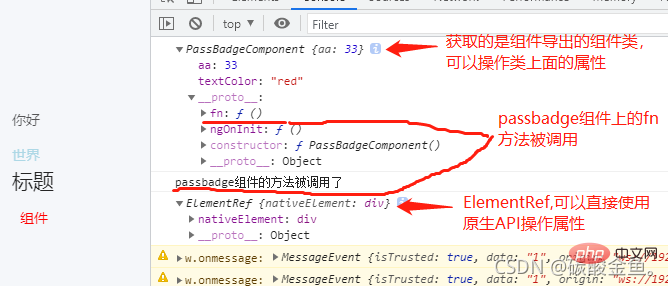Home >Web Front-end >JS Tutorial >An article to talk about how to operate DOM elements in Angular
How to operate DOM elements in Angular? The following article will introduce to you how to operate DOM elements in angular. I hope it will be helpful to you!

To obtain DOM elements in angular, you can use
javascript's native API, or introduce jQuery to operate the DOM throughjquery object, but angular has provided us with the corresponding API (ElementRef) to obtain DOM elements, so there is no need to use the native API or jQuery. [Related tutorial recommendations: "angular tutorial"]
1. Create TestComponentComponent, the template is as follows: test.component.html
<div>
<p>你好</p>
</div>
<div>
<span>世界</span>
</div>
<h1>标题</h1>
<pass-badge id="component" textColor="red">组件</pass-badge>2. Write the test.component.ts file
import { Component, OnInit } from '@angular/core';
// 1、导入 ElementRef 类
import { ElementRef} from '@angular/core';
import { PassBadge } from './compoment/pass-badge/pass-badge.component'
@Component({
selector: 'app-test',
templateUrl: './test.component.html',
styleUrls: ['./test.component.css'],
declarations: [ PassBadge ]
})
export class TestComponent implements OnInit {
// 2、将 ElementRef 类注入 test 组件中
constructor(private el:ElementRef) {}
ngOnInit() {
// 3、获取 DOM 元素
console.log(this.el.nativeElement)
console.log(this.el.nativeElement.querySelector('#component'))
}
}us Let’s see what this.el.nativeElement is

So you can pass this.el.nativeElement.querySelector('#component' ) to operate the corresponding DOM element. For example, you can change the text color
this.el.nativeElement.querySelector('#component').style.color = 'lightblue'
You can get the component through
ViewChild, and the same isContentChild,ViewChildrenandContentChildren
1. Modify the TestComponent component and add template variables to the corresponding elements. , as follows
<div>
<p>你好</p>
</div>
<!-- 1、给元素加入模板变量 div -->
<div #div>
<span>世界</span>
</div>
<h1>标题</h1>
<!-- 给组件加入模板变量 component -->
<pass-badge #component textColor="red">组件</pass-badge>2. Modify test.component.ts as follows:
import { Component, OnInit } from '@angular/core';
import { ElementRef} from '@angular/core';
// 2、引入ViewChild
import { ViewChild } from '@angular/core'
@Component({
selector: 'app-test',
templateUrl: './test.component.html',
styleUrls: ['./test.component.css']
})
export class TestComponent implements OnInit {
constructor(private el:ElementRef) {}
// 3、获取元素
@ViewChild('component') dom: any;
@ViewChild('div') div: any;
ngOnInit() {
console.log(this.dom) // PassBadgeComponent
this.dom.fn() // 调用 passbadge 组件的 fn 方法
console.log(this.div) // ElementRef
this.div.nativeElement.style.color = 'lightblue' // 文字颜色修改为淡蓝色
}
}The final result is as follows

We can know from the results that when using the
ViewChildtemplate variable to obtain the component element, what is obtained is the component class exported by the component (the above example isPassBadgeComponent). At this time Only properties contained in the component can be manipulated.When using the
ViewChildtemplate variable to obtain the html element, the class obtained is theElementReftype. At this time, you can passthis.div.nativeElement. querySelector('span')and other native APIs to operate elements
For more programming-related knowledge, please visit:Programming Video! !
The above is the detailed content of An article to talk about how to operate DOM elements in Angular. For more information, please follow other related articles on the PHP Chinese website!